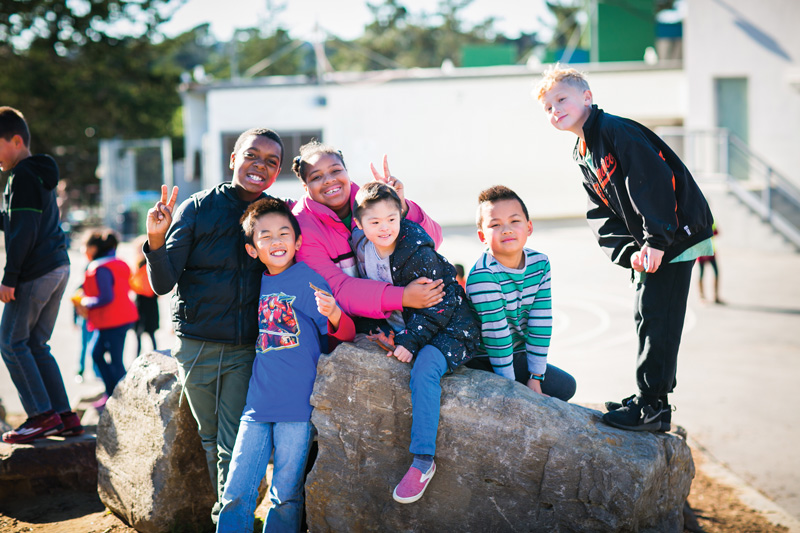More SEL, Less Discipline in Atlanta Boosted Graduation Rates for Black and Hispanic Students
In Atlanta, graduation rates among black students went up 17 percent with a new SEL program. Hispanic students showed a 25 percent rise.
 |
Students from the San Francisco Unified School District.Photo courtesy of San Francisco Unified School District |
Social and emotional learning (SEL) practices create measurable improvements in academic performance, behavior, graduation rates, and future success in college and the workplace, data has shown. These benefits have a related impact: improving equity among students.
Schools in the United States are highly unequal: Black students test on average two grade levels lower than white students in the same district, according to research from the Stanford Graduate School of Education, and black and Hispanic students are less likely than white students to earn a high school diploma. Students who enter the school system with economic and social disadvantages may have the most to gain from SEL approaches. And schools that have worked to infuse SEL principles into their communities prime their teachers and administrators to change the way they deal with kids who once would have been labeled problems.
"I think that it’s really hard to talk about self-awareness, social awareness, SEL competencies, and not talk about equity," says Lindsay Wyczalkowski, SEL coordinator for Atlanta Public Schools. "You have to model and practice what you’re talking to kids about. If you’re automatically punishing a child, you have to think about what that’s teaching them. Is that teaching them a new skill—or to be compliant or rebel?"
Concerns about inequities in school discipline prompted the Obama administration to issue guidance to schools, recommending that they review their discipline policies in order to improve disparities in sanctions. Black students, for instance, make up 16 percent of student enrollment at U.S. schools but represent 40 percent of students suspended.
The letter, issued jointly by the Department of Education and the Department of Justice, which has since been rescinded by the Federal Commission on School Safety convened by Secretary of Education Betsy DeVos, noted that disruptive behavior perceived as minor in white students is often described as menacing and threatening when coming from minority students. Schools were advised to review their discipline policies, train staff around issues of bias, and employ SEL techniques to reduce reliance on punitive discipline practices.
In Atlanta, graduation rates among black students went up 17 percentage points between 2014 and 2017 as a new SEL program was implemented district wide. Among Hispanic students, graduation rates increased 25 percent. White students’ graduation rates increased 12 percentage points during the same time frame.
In Chicago, graduation numbers also climbed after the district implemented a comprehensive SEL program with built-in supports for students experiencing trauma, such as forming in-school trauma support teams to identify at-risk students and refer them to school-based and community resources. Out-of-school suspension rates declined by 76 percent, and in-school suspension rates dropped 41 percent.
When both students and teachers buy into a "growth mind-set," or the idea that achievement and behavior can change, it can transform how they perform in the classroom, says Kevin Truitt, chief of student, family, and community support for the San Francisco Unified School District. The effect is even more pronounced among students who have experienced poverty or trauma.
Kids who don’t feel that school is a safe place for them may respond to situations in ways that "are not going to serve [them] best," Truitt says. "If you have a conflict, you can disagree but work through it in a positive way."
Believing that children can evolve in their social and emotional capabilities is at the heart of SEL. One of the most effective ways for schools to approach discipline in a manner consistent with SEL is to implement restorative justice, also known as restorative practices. This philosophy focuses on bringing together parties who have hurt each other to agree on how best to repair their relationship. The focus is on healing, rather than enforcing rigid rules.
"You’re separating the deed from the doer. You’re understanding that students have reasons for certain things," Wyczalkowski says. "When you’ve done harm, you’ve done harm to the relationship."
Drew Himmelstein is a writer and digital editor in Brooklyn, NY. She last wrote about teaching sexual consent for SLJ.
RELATED
The job outlook in 2030: Librarians will be in demand
The job outlook in 2030: Librarians will be in demand
ALREADY A SUBSCRIBER? LOG IN
We are currently offering this content for free. Sign up now to activate your personal profile, where you can save articles for future viewing





Add Comment :-
Be the first reader to comment.
Comment Policy:
Comment should not be empty !!!